|
|
|
CYCLADES - GREECE |
|
The Cyclades: During our travels through the central group of the Greek islands known as the Cyclades, we explored many whitewashed cliff top villages affording stunning views. This area of Greece is know for its beaches but the quality of sand in the Med is very course and not abundant so you see many satisfied sunbathers stretched out on the rocks in Europe! There are many historic ruins in this eastern area of Greece, the islands also differing tremendously in character and landscape. The entire area is buffeted by the infamous and fitful "Meltimi" winds that can blow to Force 7 or 8 from the North for weeks on end making planning routes challenging. Since they do not reach full force until June, we were hoping to explore Greece and move on ahead of these annoyances. |
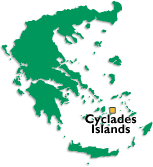 |
|
|---|---|---|
|
Mykonos May 4/09 Our 75 mile run from Patmos proved to be one of those rare perfect sails that keeps you motivated to continue cruising, fast on flat seas, steady winds behind the beam! However, as we rounded the corner to make our run down between Delos and Mykonos, the wind picked up to 30 knots on the nose, against a strong current and it took us hours of wet sailing to tack back and forth in order to make it the few miles to the harbor. We secured a spot on the wall near the main harbor of Mykonos, where the ferries and cruise ships dock. The marina was chockers but we were able to raft to a Dutch cruising boat, so when Bruce arrived, he simply stepped off the ferry boat and onto Ascension. |
||
|
Lion Terrace The famous lions, carved from Naxian marble at the end of the 7th century BC, were set up to overlook and protect the Sacred Lake |
Today the island is uninhabited, save for a myriad of iguana lizards that scurry about everywhere amidst the ruins and find refuge in the scattered collection of storage pots once used for offerings and dating from the 7th century BC. |
|
We chose an ideal time
to visit Delos as dozens
of varieties of
wildflowers were
abundant and in full bloom. Flowers draped the marble ruins and blanketed the grounds. A stunning site!! |
Bruce and I take a rest on the wall after our visit to the Archaeological Museum, Theatre and dynamic display of mosaics. |
|
Churches As in all the Greek towns, there was no shortage of churches around every corner. I loved the stark white traditional bell towers and blue domes that contrast vibrantly against the azure clear blue sky. |
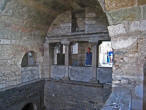 |
 |
||
 |
Church of a Hundred Doors We visited a splendid church dating form 326 AD, the building actually consisting of three distinct churches. The largest area displayed columns of marble and decorative mosaic on 2 levels. The church is the oldest in Greece in continuous use |
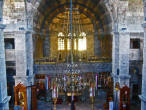 |
||
|
Touring the Island We rented a car and GB, Sara, Bruce, Gord and Ginny challenged the narrow cliffside roads around Paros Island. The road signs did not give us a sense of security by any stretch of the imagination! |
We drove through olive groves, some of the trees snarled and weathered from hundreds of years.....the stories they could tell! |
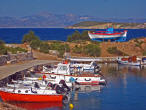 |
We followed the back roads to quaint harbors, past rural farmlands and picturesque villages perched on pastoral hillsides. |
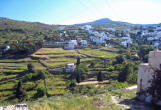 |
 |
|
Marble Quarries One of our stops was to see some marble quarries. Since antiquity Paros has been famous for its white marble which has ensured its prosperity. As we drove along the roads, huge slabs of marble were everywhere in abundance, used for building materials for everything from retaining walls to cobblestone roads. We entered the tunnels of the abandoned marble quarries at Marathi, last worked for Napoleon's tomb. The tunnels form a network but we did not have a light with us so could not venture too far into the mountain. |
 |
|
Naxos 37.06.36N 25.21.98E May 10/09 We had a wonderful sail to Naxos. Another one of those rare days when the conditions were perfect. We were glad that Bruce was able to get a good sailing day in during his stay with us. Naxos is a close neighbour to Paros and was not very far so we were securely tucked in at the marina in the main town Naxos by early afternoon. We were lucky as the quay was full but we were able to squeeze in and stern tie to the quay. The harbor master came by but would not commit to the charge for mooring there (When we checked out, he just asked us to pay what we thought it was worth for the time we were there!!). Our plan was to leave Ascension at this safe marina while we took a ferry to Santorini. Beside the fact that the weather forecast was not particularly conducive to the run south to Santorini, the anchorage there is very deep and unprotected, the marina is too shallow for our 8 foot draft. |
| Naxos island is the largest and most fertile of the Cyclades. The waterfront is a busy port bustling with cafes and a concrete mass of hotels and apartments, but Old Town Naxos was the usual charming confusing labyrinth of alleyways of a medieval fortress. Again, there were some amazing churches and cathedrals, the white domed one on the left was one of my favorites. |
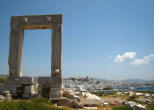 |
|
|
The harbor is dominated by
the unfinished Temple of
Apollo (Portara Gateway)
that stands on the |
||
| The old town "Kastro" is the most alluring part of Naxos with its warren of alleys, arches, tunnels around the Venetian castle on the summit. We wandered through the winding backstreets full of Venetian style dwellings, many with well kept gardens. |
|
||
|
Naxos had a superb beach where we spent a day just relaxing |
|
Touring the Island We rented a car and were glad of it as we found Naxos to be the most beautiful Greek Island we had experienced to date. Mountainous, lush and fertile, with unspoilt villages and lots of beaches. The roads were good, albeit sometimes there would be a delay as a herd of goats would commandeer the highway. |
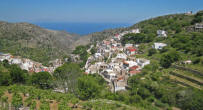 |
| The road, lined with masses of yellow wild flowers, took us through plains of olive trees and mountainous terrain. As the road twisted along the shoreline, we had awe inspiring views of the sea. |
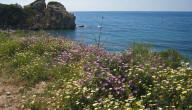 |
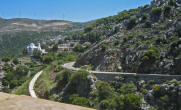 |
We travelled the
island winding
around 3000 foot
stark
Just below Mt.
Zeus, we
followed |
|
Old classic stone windmills in Greece have been replace by the sleek modern ones that stand incongruous to the surrounds....the Old and the New! |
more
marble.... As in Paros, there were lots of colossal white marble quarries, some still being mined. |
|
At
Knidross,
a short
walk led
us to a
garden
where
the
enormous
Kouros
Statue
lies on
its
side. In
the
middle
of the
orchards
is a
little
cafe of
sorts
where a
women
serves
Greek
coffee
beside
her fish
pond. |
 |
|
Back
at
the
boat,
Bruce
treated
us
to
some
of
his
famous
Margaritas.
We
made
plans
to
take
a
ferry
to
Santorini
the
following
day
because
the
weather
seemed
so
unsettled
to
sail
there
and
the
boat
was
safely
moored
at
the
dock
in
Naxos. NEXT>>>> CYCLADES (con't) SANTORINI |